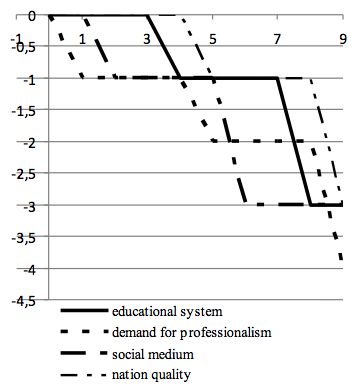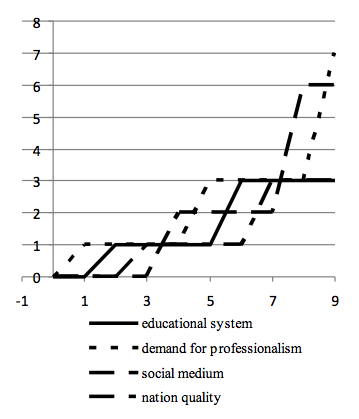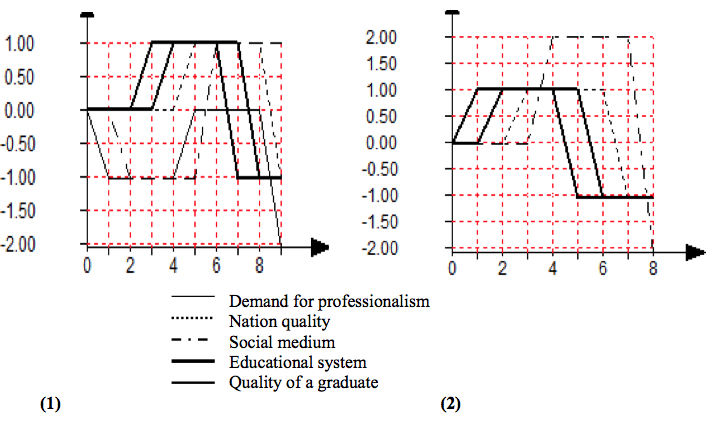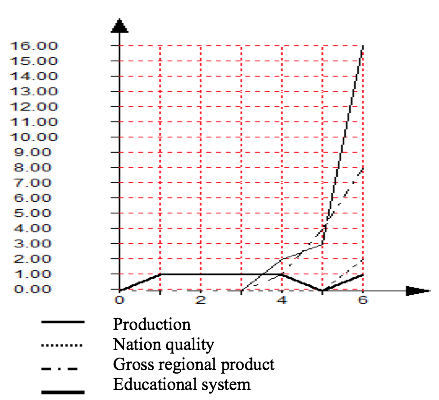

 Especial • Vol. 38 (Nº 56) Year 2017. Page 17
Especial • Vol. 38 (Nº 56) Year 2017. Page 17
Galina Viktorovna GORELOVA 1; Nikolay Nikolaevich LYABACH 2; Saida Kazbekovna KUIZHEVA 3
Recibido: 26/10/2017 • Aprobado: 25/11/2017
ABSTRACT: The article deals with the features and problems of interrelation and mutual influence of the educational system and society (social medium), which are proposed to be displayed through the cognitive model. A number of cognitive modeling features, imposing restriction on the modeling technology and the corresponding computational experiment, are noted. A number of research results on the interrelation of the educational system and society are demonstrated through the developed cognitive model. These results allow using the model to trace, comprehend and evaluate the consequences of possible changes in the society under the influence of both external disturbing effects and administrative decisions (for example, in the form of reforms, strategic directions of innovative educational policy, etc.). Computational experiment provides the basis for scientific foresight of the consequences of various perturbing and controlling influences on the educational system. |
RESUMEN: El artículo aborda las características y problemas de interrelación e influencia mutua del sistema educativo y de la sociedad (medio social), que se proponen para mostrarse a través del modelo cognitivo. Se observan una serie de características cognitivas de modelado, la imposición de restricciones a la tecnología de modelado y el experimento computacional correspondiente. Un número de resultados de la investigación sobre la interrelación del sistema educativo y de la sociedad se demuestran con el modelo cognoscitivo desarrollado. Estos resultados permiten utilizar el modelo para trazar, comprender y evaluar las consecuencias de los posibles cambios en la sociedad bajo la influencia de los efectos perturbadores externos y de las decisiones administrativas (por ejemplo, en forma de reformas, estratégicas direcciones de la política educativa innovadora, etc.). El experimento computacional proporciona la base para la previsión científica de las consecuencias de diversas influencias perturbadoras y controladoras en el sistema educativo. |
In today's world, when mankind has to deal with the growing global problems, the importance of education as the most significant factor of the new quality formation not only in the economy, but in the society as a whole, also increases. That is, the educational system in modern society should become a reliable "tool", through which the future of the country and the world is built. In developed countries, the educational sphere has already turned into a leading factor in economic growth. Each unit of education expenditures can yield returns of up to 2 units of produced GDP.
The educational system and the society (social medium) have various interrelations with each other. Their interaction determines the socio-economic and political state of any country, the competitiveness of its economy, national security and the possibility of sustainable development. The study on the interrelations between the educational system and the society is a serious problem that does not lose its relevance, the solution of which requires the application of a systematic approach (Volkova et al., 2015). Both the educational system and the society are complex systems if taken separately and as a whole. Since education and society are complex systems, which are studied for the purpose of understanding, explaining, describing (developing a model), foreseeing (forecasting) possible ways of development, managing them or adapting to them, then a "full-scale experiment" thereon is extremely undesirable. It is expensive, time consuming, and can have dangerous consequences of ill-considered managerial decisions. Therefore, in order to achieve these goals, it is desirable to premodel, simulate the structures and various behaviors of a real complex system. The realization of this possibility is seen in the way of applying the methodology for cognitive modeling of complex systems (Axelrod, 1976; Roberts, 1978; Casti, 1979; Eden, 1998; Gorelova, & Dzharimov, 2002; Gorelova, & Pankratova, 2015, pp. 2-9).
Cognitive technologies were developed to solve weakly structured problems of complex systems within the framework of the "Cognitive Analysis and Situations Development Management" program, and used the ideas of cognitive psychology, as well as mathematical models proposed in the works by F. Roberts, R. Axelrod, J. Casti, etc. (Axelrod, 1976; Roberts, 1978; Casti, 1979, pp. 6-9).
In this study, the cognitive methodology of complex systems research is understood as the logical organization of the researcher's activity, which consists in determining the goal, object and subject of research, methods and information technologies of cognitive modeling, which allow understanding the mechanism of phenomena and processes in the object, developing possible scenarios for its development, choosing effective solutions on the management of object and/or its adaptation to the environment. Cognitive methodology is supported by the program system of cognitive modeling (PSCM) (Eden, 1998), which is a cognitive information technology.
The cognitive modeling of weakly structured problems of complex systems (Gorelova, & Pankratova, 2015) means the solution of complex problems: the identification of an object (application of expert, statistical and other methods), the analysis of ways and cycles of the cognitive model (graph theory methods), the analysis of observability, controllability, stability, sensitivity, adaptability, and catastrophes (methods of the control theory and the catastrophe theory); compositions-decompositions; analysis of various aspects of complexity, connectivity analysis (methods of the graph theory, topological analysis of q-connectivity (Shukshunov, & Ovsyannikov, 1998a)); system self-organization (synergetics, the theory of complex systems); forecasting (statistical methods); scientific foresight (scenario analysis, analysis of situation development – impulse simulation); solution of optimization problems (solution of the inverse problem, methods of mathematical programming); decision-making under conditions of various uncertainties (methods of decision-making theory), which accompany the existence and study of a complex system. At the same time, decision-making takes place both in relation to the studied object itself and in relation to the research process.
Next, we analyze the following features of cognitive modeling, important for this study:
- Cognitive modeling allows the detection of positive and negative backlinks in the structure of the system under study. The former ones lead either to unlimited growth or to uncontrolled degradation of the system. It is necessary to develop mechanisms for controlled growth and stabilization of the system at a given level of development. The latter task is solved by introducing a negative backlink into the system.
- The complexity of systems explored by means of cognitive analysis requires the development of multilevel modeling. At the upper, strategic level reflecting macroprocesses, one can neglect details. At this level, managerial decisions of a structural nature are made. At the lower (tactical) level, particular parameters of the system are investigated and control actions at the subsystem level are formed.
- The PSCM system is usually used by linear and stationary models of the relationship between variables that are studied in cognitive analysis. This is mainly due to the lack of necessary information for constructing adequate nonlinear, nonstationary models. Therefore, their use is justified only on limited time intervals and parameters. This requires an iterative calculation procedure, and thus a piecewise linear approximation of nonlinear and nonstationary process models is realized.
Let us consider these features of the cognitive technology for the above-mentioned object of study: the relationship of the educational system with the society. The possibility of presenting the educational system in its relationship with the society as a cognitive model is substantiated in the works of V.E. Shukshunov and A.A. Ovsyannikov (Shukshunov, & Ovsyannikov, 1998a, 1998b).
There is a chain of interconnected social problems of interaction between the society and the educational system within the state (Figure 1) (Gorelova, & Dzharimov, 2002). Thus, the decline in the nation quality, the value of human capital (Z3) in the society leads to the weakening of incentives for social mobility, i.e. moving "up" along the social pyramid, depending on education, intelligence, talent, and diligence, while in turn reducing the value of education.
Figure 1
Enlarged cognitive map G0 of interrelations between
the educational system and the society

This leads to a decrease in the public and family interest in the educational system (Y), its degradation (loss of quality, systematicity, scale), and further to a decrease in the personal and physical qualities of graduates (Y10). And this further leads to a decrease in professionalism and the demand for professionalism (Z1), which has a negative impact on production (Z4). Such a result of the educational system activity causes a further decline in the value of human capital, etc. That is, positive backlinks are formed, which are the "maniacal loops" that entice the entire system as a whole. The task of the state is to "break" these positive backlinks. It should be noted that the severity of this problem still exists (Gorelova, & Dzharimov, 2002).
For a deeper cognitive analysis of the interrelations between the educational system and the society at the present stage, the scheme of Figure 1 can be taken as a basis with its subsequent filling and interpreting the results in accordance with the educational policy of the state and socio-economic indicators of the Russian Federation in recent years. The performed research made it possible to form a cognitive map implemented in a special program system detailing the interrelations between the educational system and various indicators of the society status that affect the population's quality of life and education.
Let us present some results of the system property studies depicted in Figure 1. The illustration of the possibilities of cognitive modeling on a cognitive map with a small number of vertices is convenient because of its clarity (visualization of the results of decisions taken in dynamics is one of the advantages of PSCM).
At the stages of analyzing the structure of the system displayed by the cognitive map and its stability, we obtain the following result: there are two positive cycles in the system – the previously described loops of positive backlink, the "left loop" (Z1 Z У У10 Z1) and the "right loop" (Z3 Z У У10 Z3). This fact testifies to the structural instability of the system, in addition, the system is not stable to perturbations (according to the corresponding theorems (Casti, 1979)). This observation can be confirmed by the graphs of impulse processes, Figures 3, 4, which reflect the continuous fall/growth of the indicators (impulses) at the vertices that do not tend to any limit. Pulse simulation is carried out by introducing perturbations into certain vertices of the cognitive map, which are selected by the expert (researcher) at the planning stage of the computational experiment, based on some assumptions (see Figures).
The scenario of the situation development is a set of impulse processes in the totality of the cognitive map vertices, which are caused by perturbations introduced into the vertices. On the graphs of Figures 2,3, the simulation cycles (0, 1, 2, 3, … the number planned by the experimenter in accordance with the desired forecasting horizon) are displayed along the abscissa. The axis of ordinates indicates the values of impulses formed at the vertices, as they are traversed (note that in the event of impulse simulation, the relative vector quantities may not be relative values, but specific, absolute ones).
Figure 2
Scenario 1: The demand for professionalism is reduced, which is modeled by
the introduction of a disturbing effect q1 = -1. The perturbation vector Q = { q1 = -1;0;0;0;0}

-----
Figure 3
Scenario 2: The educational system "gets better", which is modeled by
the introduction of a disturbing effect qy = +1. Perturbation vector

Q = { 0;0;0; qy = +1;0}
Scenario 1 (Figure 3) illustrates the degradation of the system; Scenario 2 (Figure 4) is the unreasonable unlimited growth (associated with a simplified linear model). Both scenarios characterize the effect of positive backlink.
Most often, the first series of computational experiments (as in the example given) show the need to correct the starting cognitive model G0. In this case, this model successfully illustrates the assumption of the negative influence of "maniacal loops", but does not answer the question on how to neutralize their influence. It is necessary to change the nature of a backlink in the system (to replace a positive backlink, which "accelerates" the process, with a negative one, which stabilizes it). In our example, this can be achieved by changing the sign of the arc between the vertices Z "Social medium" and Y "Educational system" from "+1" to "-1". This assumes that the deteriorating state of the society initiates the improvement of the educational system. This immediately changes the nature of the impulse processes (Figure 4).
Figure 4
Scenarios: (1) q1 = -1, perturbation vector Q = {q1 = -1;0;0;0;0};
(2) qy = +1; Perturbation vector Q = {0;0;0; qy = +1;0}

The system enters an increasing oscillatory regime with a variable improvement or deterioration of situations. Such a state of affairs cannot be considered acceptable as well. The modeling should be continued apparently until the conditions for "sustainable development" are found.
The above example can also serve to illustrate that unnecessarily "straightforward" recommendations such as "improve", "enhance", etc. can have the desired effect only for a certain period of time. See, for example, the development of the processes in Figure 5. Stability is observed in up to 4 modeling cycles, but further the picture of events’ development deteriorates. In such a situation, the used linear model should be updated. That is, it is necessary to use the model of new iteration according to the requirement introduced above – piecewise linear approximation of complex real processes. If the effect is confirmed (that is, it does not depend on the inadequacy of model), then it is necessary to introduce an additional control action on the 4th cycle in order to exclude the "undesirable future".
All the above reasoning, based on various variations of the cognitive map G0, is quite abstract. However, it does not contradict the trivial opinion that the educational system affects the nation quality. However, what can this influence be in the future, taking into account many factors, at least 4 more, forming the constructed cognitive map, and with changes in the vertices? The answer to this question is no longer banal.
Figure 6 shows a fragment of the scenario corresponding to the refined diagram in Figure 2 and the assumption on consequences of possible improvement in the educational system for the related thereto changes in the remaining vertices (Figure 6 shows only 4 vertices for the purpose of conclusion clarity). As it is seen from Figure 5, already after the third cycle of modeling, positive tendencies of indicator growth are observed.
Figure 5
Scenario: q14 = +1, perturbation vector Q = { 0, 0,…0, q14 = +1}

Then we again observe an unreasonably sharp growth explained by the inadequacy of the simplified linear model. Figures 3-6 illustrate the situation only partially, but this part is the main one (especially at the initial stages of research) for the possibilities and results of cognitive modeling of complex systems, ideas of cognitive approach and interdisciplinary issue.
When verifying the results of modeling, the following question may arise: what is the meaning of the expression "let the educational system become "better"? What real management solutions can help to achieve it? The answer to these questions can be sought in various development programs and strategies, decrees, orders, articles related to the educational system (Borovskaya et al., 2012, Belokrylova et al., 2004). These may be the researcher's recommendations as well. However, in any case, by using the tools of cognitive modeling, it is possible to check and evaluate the consequences of recommendations.
The toolkit of cognitive modeling makes it possible to conduct a multidimensional analysis of complex systems, helping decision-makers find non-trivial management decisions and scientifically anticipate their consequences. The proposed tool for cognitive modeling of complex systems that implements the research metamodel, is a systematic, ordering research factor that makes it possible to consider the entire complex system interrelatedly, both in its entirety and in its individual elements and aspects.
Axelrod, R. (1976). The Structure of Decision: Cognitive Maps of Political Elites. Princeton: University Press.
Belokrylova, O.S., Germanova, O.E., Volchik, V.V., & Mikhalkina, E.V. (2014). Evolyutsiya institutsionalnoi sistemy obrazovaniya kak sledstvie zavisimosti ot predydushchego puti razvitiya [Evolution of the Institutional System of Education as a Consequence of Dependence on the Previous Path of Development]. Ekonomicheskii vestnik Rostovskogo gosudarstvennogo universiteta, 2(4), 60-73.
Borovskaya, M.A., Bechvaya, M.R., & Masych, M.A. (2012). Analiz sovremennoi sistemy sotsialno-trudovykh otnoshenii [Analysis of the Modern System of Social and Labor Relations]. Izvestiya YuFU. Tekhnicheskie nauki, 8(133), 15-21.
Casti, J. (1979). Connectivity, Complexity and Catastrophe in Large-Scale Systems. Chichester, New York, Brisbane, Toronto: International Institute for Systems Analysis; John Wiley & Sons.
Eden, C. (1998). Cognitive Mapping. European Journal of Operational Research, 36, 1-13.
Gorelova, G.V., & Dzharimov, N.Kh. (2002). Regionalnaya sistema obrazovaniya, metodologiya kompleksnykh issledovanii [Regional Educational System, Methodology of Integrated Research]. Krasnodar, GPU Kuban. (p. 358).
Gorelova, G.V., & Pankratova, N.D. (Eds.). (2015). Innovatsionnoe razvitie sotsio-ekonomicheskikh sistem na osnove metodologii predvideniya i kognitivnogo modelirovaniya [Innovative Development of Socio-Economic Systems Based on the Methodologies of Foresight and Cognitive Modeling]. Kyiv: Naukova Dumka. (p. 463).
Roberts, F. (1978). Graph Theory and Its Applications to Problems of Society. Philadelphia: Society for Industrial and Applied Mathematics.
Shukshunov, V.E., & Ovsyannikov, A.A. (1998a). Sistemnaya model organizatsionno-ekonomicheskoi reformy obrazovaniya v Rossii [The System Model of the Organizational and Economic Reform of Education in Russia]. Moscow: MANVSH. (p. 46).
Shukshunov, V.E., & Ovsyannikov, A.A. (1998b). Strategiya i taktika reformirovaniya sistemy obrazovaniya v Rossii [Strategy and Tactics of Reforming the Educational System in Russia]. Moscow: MANVSH. (p. 41).
Volkova, V.N., & Kozlov, V.N. (Eds.). (2015). Modelirovanie sistem i protsessov: uchebnik [Modeling of Systems and Processes: Textbook]. Moscow: YURAYT. (p. 592).
1. The Southern Federal University, Russia, 344006, Rostov-on-Don, Bolshaya Sadovaya St., 105/4 E-mail: gorelova-37@mail.ru
2. The Southern Federal University, Russia, 344006, Rostov-on-Don, Bolshaya Sadovaya St., 105/4 E-mail: liabakh@rambler.ru
3. Maikop State Technological University, Russia, 385000, Adygeya, Maikop, Pervomayskaya St., 191 E-mail: rector@mkgtu.ru